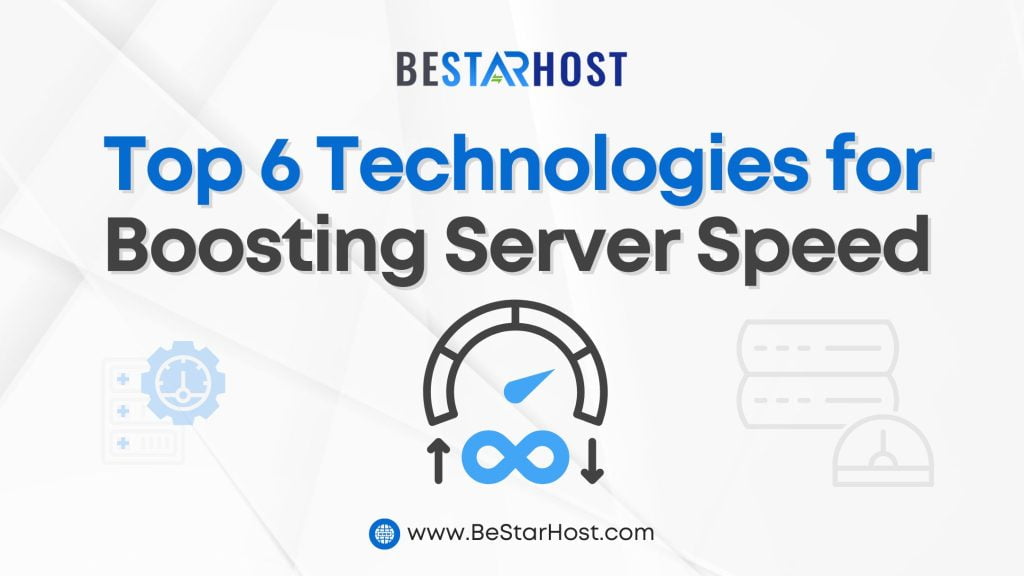 In today’s digital age, where users expect websites to load instantly, ensuring fast server speeds is crucial for any online business. Slow servers can lead to poor user experience, decreased traffic, and lost revenue. To help you navigate the world of server optimization, we’ve compiled a list of the top 6 technologies to boost server speed. At BeStarHost.com, we prioritize high-performance hosting, and these technologies play a significant role in delivering exceptional service. Let’s dive into how you can improve server performance effectively.
In today’s digital age, where users expect websites to load instantly, ensuring fast server speeds is crucial for any online business. Slow servers can lead to poor user experience, decreased traffic, and lost revenue. To help you navigate the world of server optimization, we’ve compiled a list of the top 6 technologies to boost server speed. At BeStarHost.com, we prioritize high-performance hosting, and these technologies play a significant role in delivering exceptional service. Let’s dive into how you can improve server performance effectively.
1. Solid-State Drives (SSDs)
How SSDs Improve Server Performance
Switching from traditional hard disk drives (HDDs) to solid-state drives (SSDs) is one of the most impactful ways to optimize server performance. SSDs offer significantly faster data read/write speeds, which can drastically reduce load times and improve the overall responsiveness of your server. By storing data on flash memory, SSDs provide quicker access compared to the mechanical components of HDDs.
Benefits of SSDs
- Faster boot times
- Reduced latency
- Enhanced data transfer rates
- Improved reliability and durability
2. Content Delivery Network (CDN)
How CDNs Speed Up Servers
A Content Delivery Network (CDN) is a system of distributed servers that deliver web content to users based on their geographic location. By caching static content like images, CSS, and JavaScript files across multiple data centers worldwide, a CDN can significantly reduce the load on your primary server and improve load times for users, no matter where they are located.
Benefits of CDNs
- Reduced latency
- Improved load times
- Enhanced user experience
- Load balancing and redundancy
3. Server-Side Caching
How Server-Side Caching Works
Server-side caching involves storing frequently accessed data in memory for quick retrieval, thereby reducing the need to process the same information repeatedly. Technologies like Memcached and Redis are popular choices for implementing server-side caching. By caching database queries, API calls, and HTML pages, you can drastically improve server performance.
Benefits of Server-Side Caching
- Faster data retrieval
- Reduced server load
- Enhanced scalability
- Improved application performance
4. Load Balancers
How Load Balancers Optimize Server Performance
Load balancers distribute incoming traffic across multiple servers, ensuring no single server becomes a bottleneck. This not only helps in handling high traffic volumes but also provides redundancy in case one server fails. By implementing load balancing, you can improve server performance, ensure high availability, and enhance the user experience.
Benefits of Load Balancers
- Efficient traffic distribution
- Improved scalability
- High availability and redundancy
- Enhanced fault tolerance
5. HTTP/2 Protocol
How HTTP/2 Speeds Up Servers
The HTTP/2 protocol introduces several improvements over its predecessor, HTTP/1.1, that can help speed up server performance. These include multiplexing, which allows multiple requests and responses to be sent simultaneously over a single connection, and header compression, which reduces overhead. By adopting HTTP/2, you can optimize server performance and reduce page load times.
Benefits of HTTP/2
- Reduced latency
- Faster load times
- Improved connection efficiency
- Enhanced user experience
6. Database Optimization
How to Improve Server Performance with Database Optimization
Databases are often a critical component of server infrastructure, and optimizing them can lead to significant performance gains. Techniques such as indexing, query optimization, and regular maintenance can help improve server performance. Additionally, using technologies like MySQL’s InnoDB or PostgreSQL can provide better performance for read/write operations.
Benefits of Database Optimization
- Faster query execution
- Reduced server load
- Improved data retrieval times
- Enhanced scalability
Boosting server speed is essential for delivering a seamless user experience and maintaining a competitive edge. By implementing these top 6 technologies—SSDs, CDNs, server-side caching, load balancers, HTTP/2, and database optimization—you can significantly improve server performance and ensure your website or application runs smoothly. At BeStarHost.com, we leverage these technologies to provide our clients with high-performance hosting solutions. Whether you’re looking to speed up your server or optimize server performance, these strategies are key to achieving your goals.
For more insights and tips on how to improve server performance,tay connected with us and get updated with the latest in server optimization technologies.
Additional Tips for Improving Server Performance
Beyond the top 6 technologies, here are some additional tips to further optimize server performance:
- Regularly Update Software: Keep your server software, including the operating system, web server, and database management system, up to date to benefit from the latest performance enhancements and security patches.
- Minimize Resource-Heavy Plugins: Limit the use of resource-heavy plugins and modules on your server. Evaluate their necessity and look for more efficient alternatives.
- Optimize Code and Assets: Ensure your website or application code is optimized. Minify CSS and JavaScript files, compress images, and use asynchronous loading for scripts to reduce load times.
- Monitor Performance: Use monitoring tools to track server performance and identify bottlenecks. Tools like New Relic, Datadog, and Nagios can provide valuable insights into server health and performance.
- Implement Gzip Compression: Enable Gzip compression on your web server to reduce the size of files sent to the browser, speeding up load times for users.
By combining these tips with the top 6 technologies, you can create a robust strategy to speed up your server and deliver an outstanding user experience.
For more expert advice on how to improve server performance, follow the BeStarHost.com stay ahead of the curve with the latest advancements in server optimization.
